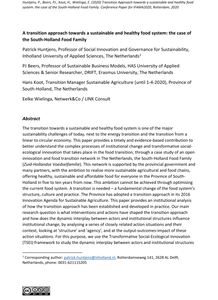Moral food lab: Transforming the food system with crowd-sourced ethics
LINK
The transition towards a sustainable and healthy food system is one of the major sustainability challenges of today, next to the energy transition and the transition from a linear to circular economy. This paper provides a timely and evidence-based contribution to better understand the complex processes of institutional change and transformative social-ecological innovation that takes place in the food transition, through a case study of an open innovation and food transition network in The Netherlands, the South-Holland Food Family (Zuid-Hollandse Voedselfamilie). This network is supported by the provincial government and many partners, with the ambition to realize more sustainable agricultural and food chains, offering healthy, sustainable and affordable food for everyone in the Province of South-Holland in five to ten years from now. This ambition cannot be achieved through optimising the current food system. A transition is needed – a fundamental change of the food system’s structure, culture and practice. The Province has adopted a transition approach in its 2016 Innovation Agenda for Sustainable Agriculture. This paper provides an institutional analysis of how the transition approach has been established and developed in practice. Our main research question is what interventions and actions have shaped the transition approach and how does the dynamic interplay between actors and institutional structures influence institutional change, by analysing a series of closely related action situations and their context, looking at 'structure' and 'agency', and at the output-outcomes-impact of these action situations. For this purpose, we use the Transformative Social-Ecological Innovation (TSEI)-framework to study the dynamic interplay between actors and institutional structures influencing institutional change. The example of TSEI-framework application in this paper shows when and how local agents change the institutional context itself, which provides relevant insights on institutional work and the mutually constitutive nature of structure and agency. Above institutional analysis also shows the pivotal role of a number of actors, such as network facilitators and provincial minister, and their capability and skills to combine formal and informal institutional environments and logics and mobilize resources, thereby legitimizing and supporting the change effort. The results are indicative of the importance of institutional structures as both facilitating (i.e., the province’s policies) and limiting (e.g. land ownership) transition dynamics.
DOCUMENT

BackgroundScientific software incorporates models that capture fundamental domain knowledge. This software is becoming increasingly more relevant as an instrument for food research. However, scientific software is currently hardly shared among and (re-)used by stakeholders in the food domain, which hampers effective dissemination of knowledge, i.e. knowledge transfer.Scope and approachThis paper reviews selected approaches, best practices, hurdles and limitations regarding knowledge transfer via software and the mathematical models embedded in it to provide points of reference for the food community.Key findings and conclusionsThe paper focusses on three aspects. Firstly, the publication of digital objects on the web, which offers valorisation software as a scientific asset. Secondly, building transferrable software as way to share knowledge through collaboration with experts and stakeholders. Thirdly, developing food engineers' modelling skills through the use of food models and software in education and training.
DOCUMENT

Human kind has a major impact on the state of life on Earth, mainly caused by habitat destruction, fragmentation and pollution related to agricultural land use and industrialization. Biodiversity is dominated by insects (~50%). Insects are vital for ecosystems through ecosystem engineering and controlling properties, such as soil formation and nutrient cycling, pollination, and in food webs as prey or controlling predator or parasite. Reducing insect diversity reduces resilience of ecosystems and increases risks of non-performance in soil fertility, pollination and pest suppression. Insects are under threat. Worldwide 41 % of insect species are in decline, 33% species threatened with extinction, and a co-occurring insect biomass loss of 2.5% per year. In Germany, insect biomass in natural areas surrounded by agriculture was reduced by 76% in 27 years. Nature inclusive agriculture and agri-environmental schemes aim to mitigate these kinds of effects. Protection measures need success indicators. Insects are excellent for biodiversity assessments, even with small landscape adaptations. Measuring insect biodiversity however is not easy. We aim to use new automated recognition techniques by machine learning with neural networks, to produce algorithms for fast and insightful insect diversity indexes. Biodiversity can be measured by indicative species (groups). We use three groups: 1) Carabid beetles (are top predators); 2) Moths (relation with host plants); 3) Flying insects (multiple functions in ecosystems, e.g. parasitism). The project wants to design user-friendly farmer/citizen science biodiversity measurements with machine learning, and use these in comparative research in 3 real life cases as proof of concept: 1) effects of agriculture on insects in hedgerows, 2) effects of different commercial crop production systems on insects, 3) effects of flower richness in crops and grassland on insects, all measured with natural reference situations